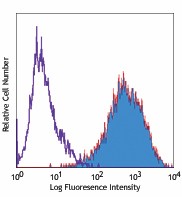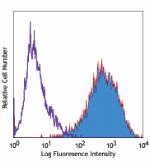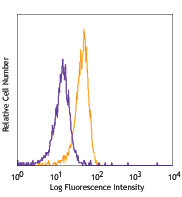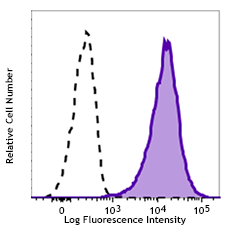- Clone
- MD5-1 (See other available formats)
- Regulatory Status
- RUO
- Other Names
- DR5, TRAIL-R2, TNFRS10B, TRICK2, KILLER
- Isotype
- Armenian Hamster IgG
- Ave. Rating
- Submit a Review
- Product Citations
- publications

-

Mouse DR5 transfected cells stained with MD5-1 PE
| Cat # | Size | Price | Quantity Check Availability | Save | ||
|---|---|---|---|---|---|---|
| 119905 | 50 µg | 108€ | ||||
| 119906 | 200 µg | 327€ | ||||
CD262 is a 55 kD protein also known as DR5, TRAIL-R2, Apo-2, TRICK2, and KILLER. DR5 is member 10B of the TNF receptor superfamily (TNFRSF10B), widely expressed in normal tissues and some tumor cell lines. The DR5 receptor binds to TRAIL and interacts with the cytoplasmic proteins TRADD and RIP. TRAIL binding to DR5 activates NF- κB and induces apoptosis. DR5 is induced by wild-type p53.
Product DetailsProduct Details
- Verified Reactivity
- Mouse
- Antibody Type
- Monoclonal
- Host Species
- Armenian Hamster
- Immunogen
- Mouse DR5-Ig fusion protein
- Formulation
- Phosphate-buffered solution, pH 7.2, containing 0.09% sodium azide.
- Preparation
- The antibody was purified by affinity chromatography, and conjugated with PE under optimal conditions.
- Concentration
- 0.2 mg/ml
- Storage & Handling
- The antibody solution should be stored undiluted between 2°C and 8°C, and protected from prolonged exposure to light. Do not freeze.
- Application
-
FC - Quality tested
- Recommended Usage
-
Each lot of this antibody is quality control tested by immunofluorescent staining with flow cytometric analysis. For flow cytometric staining, the suggested use of this reagent is ≤0.25 µg per million cells in 100 µl volume. It is recommended that the reagent be titrated for optimal performance for each application.
- Excitation Laser
-
Blue Laser (488 nm)
Green Laser (532 nm)/Yellow-Green Laser (561 nm)
- Application Notes
-
Additional reported applications (for the relevant formats) include: in vitro and in vivo induction of cytotoxicity2,3. The Ultra-LEAF™ purified antibody (Endotoxin < 0.01 EU/μg, Azide-Free, 0.2 μm filtered) is recommended for functional assays (Cat. No. 119909).
- Application References
- Product Citations
-
- RRID
-
AB_345401 (BioLegend Cat. No. 119905)
AB_2205065 (BioLegend Cat. No. 119906)
Antigen Details
- Structure
- Type I transmembrane protein, TNF receptor superfamily member, homotrimer, predicted molecular weight 55 kD
- Distribution
-
Widely expressed in normal tissues and some tumor cell lines. Expression regulated by the tumor suppressor p53
- Function
- Binds to TRAIL, activates NF- ?B, induces apoptosis. May be involved in the regulation of tumor metastases.
- Ligand/Receptor
- TRAIL (CD253); cytoplasmic domain interacts with TRADD and RIP
- Biology Area
- Apoptosis/Tumor Suppressors/Cell Death, Cell Biology, Immunology
- Molecular Family
- CD Molecules, Cytokine/Chemokine Receptors
- Antigen References
-
1. Wu GS, et al. 1999. Cancer Res. 59:2770.
- Gene ID
- 21933 View all products for this Gene ID
- UniProt
- View information about CD262 on UniProt.org
Related FAQs
- What type of PE do you use in your conjugates?
- We use R-PE in our conjugates.
Other Formats
View All CD262 Reagents Request Custom Conjugation| Description | Clone | Applications |
|---|---|---|
| Biotin anti-mouse CD262 (DR5, TRAIL-R2) | MD5-1 | FC |
| PE anti-mouse CD262 (DR5, TRAIL-R2) | MD5-1 | FC |
| Ultra-LEAF™ Purified anti-mouse CD262 (DR5, TRAIL-R2) | MD5-1 | FC,Cyt |
Customers Also Purchased
Compare Data Across All Formats
This data display is provided for general comparisons between formats.
Your actual data may vary due to variations in samples, target cells, instruments and their settings, staining conditions, and other factors.
If you need assistance with selecting the best format contact our expert technical support team.
-
Biotin anti-mouse CD262 (DR5, TRAIL-R2)
-
PE anti-mouse CD262 (DR5, TRAIL-R2)

Mouse DR5 transfected cells stained with MD5-1 PE -
Ultra-LEAF™ Purified anti-mouse CD262 (DR5, TRAIL-R2)

Mouse DR5 transfected cells stained with Ultra-LEAF™ purifie...
 Login / Register
Login / Register 

















Follow Us